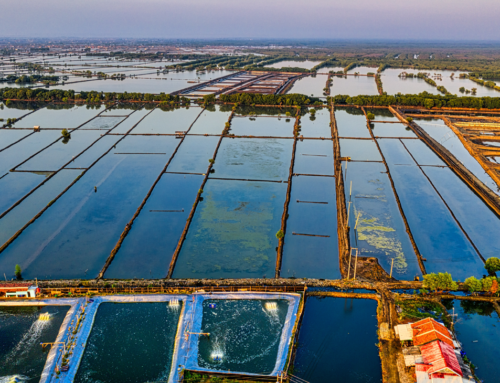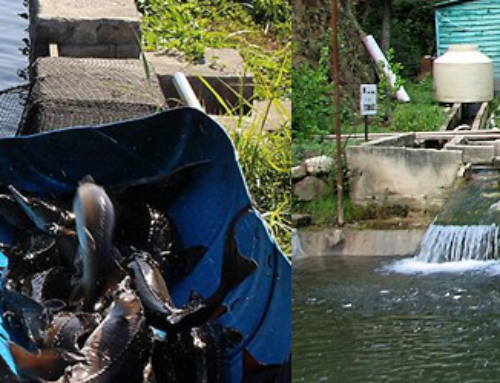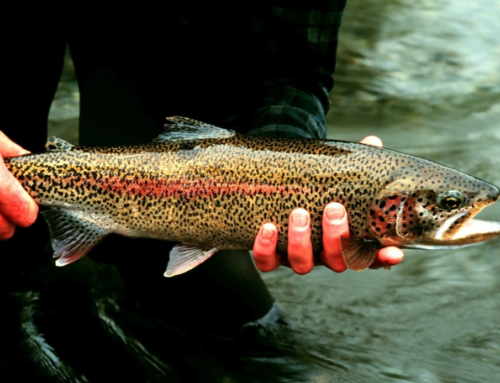The Key Fish Feed Ingredients Energy-yielding Nutrients There is considerable variation in the ability of fish species to use the energy-yielding nutrients. This variation is associated with their natural feeding habits, which are classified as herbivorous, omnivorous or carnivorous. The foods carnivorous species eat contain little carbohydrate, so they use this nutrient less efficiently. In terms of energy density, proteins, carbohydrates and lipids have average caloric values of 5.65, 4.15 and 9.45 kilocalories per gram (kcal/g), respectively. Proteins and amino acids. Proteins consist of various amino acids, the composition of which gives individual proteins their unique characteristics. Many of the biochemicals required for normal bodily functions are proteins, such as enzymes, hormones and immunoglobulins. Fish, like other animals, synthesize body proteins from amino acids in the diet and from some other sources. Amino acids that must be provided in the diet are called “essential” or “indispensable” amino acids. Quantitative dietary requirements for the ten indispensable amino acids have been determined for several fish species (Wilson, 2002). Table 1 lists indispensable and dispensable amino acids. A deficiency of any one of the indispensable amino acids can limit protein synthesis, which often causes reduced weight gain and other specific symptoms.
Proteins and amino acids. Proteins consist of various amino acids, the composition of which gives individual proteins their unique characteristics. Many of the biochemicals required for normal bodily functions are proteins, such as enzymes, hormones and immunoglobulins. Fish, like other animals, synthesize body proteins from amino acids in the diet and from some other sources. Amino acids that must be provided in the diet are called “essential” or “indispensable” amino acids. Quantitative dietary requirements for the ten indispensable amino acids have been determined for several fish species (Wilson, 2002). Table 1 lists indispensable and dispensable amino acids. A deficiency of any one of the indispensable amino acids can limit protein synthesis, which often causes reduced weight gain and other specific symptoms.  Two Major Classes of Amino Acids. Most herbivorous and omnivorous fish evaluated to date require a diet with 25 to 35 percent crude protein; carnivorous species may require 40 to 50 percent crude protein (Wilson, 2002).
Two Major Classes of Amino Acids. Most herbivorous and omnivorous fish evaluated to date require a diet with 25 to 35 percent crude protein; carnivorous species may require 40 to 50 percent crude protein (Wilson, 2002).  Carbohydrates. Fish do not have a specific dietary requirement for carbohydrates, but including these compounds in diets is an inexpensive source of energy. The ability of fish to utilize dietary carbohydrate for energy varies considerably; many carnivorous species use it less efficiently than do herbivorous and omnivorous species (Wilson, 1994). Some carbohydrate is deposited in the form of glycogen in tissues such as liver and muscle, where it is a ready source of energy. Some dietary carbohydrate is converted to lipid and deposited in the body for energy. The amount of crude fiber in fish feeds is usually less than 7 percent of the diet to limit the amount of undigested material entering the culture system. Prepared feeds for carnivorous fish usually contain less than 20 percent soluble carbohydrate, while feeds for omnivorous species usually contain 25 to 45 percent. In addition to being a source of energy, soluble carbohydrate in fish feed also gives pellets integrity and stability and makes them less dense. Soluble carbohydrates such as starch are primary energy reserves found in seeds, tubers and other plant structures. Lipids. This nutrient group consists of several different compounds. Neutral lipids (fats and oils), in the form of triglycerides, provide a concentrated source of energy for aquatic species. Dietary lipid also supplies essential fatty acids that cannot be synthesized by the organism (Sargent et al., 1995). Fatty acids of the linoleic acid (n-3) family are generally more essential to fish than those of the linoleic acid (n-6) family. Minerals. This nutrient group consists of inorganic elements the body requires for various purposes. Fish require the same minerals as terrestrial animals for tissue formation, osmoregulation and other metabolic functions (Lall, 2002). However, dissolved minerals in the water may satisfy some of the metabolic requirements of fish. Minerals are typically classified as either macro- or microminerals, based on the quantities required in the diet and stored in the body. Macrominerals are calcium, phosphorus, magnesium, chloride, sodium, potassium and sulfur. Dietary deficiencies of most macrominerals have been difficult to produce in fish because of the uptake of waterborne ions by the gills. However, it is known that phosphorus is the most critical macromineral in fish diets because there is little phosphorus in water. Chloride, sodium and potassium are important electrolytes involved in osmoregulation and the acid–base balance in the body (Lall, 2002). These minerals are usually abundant in water and practical feedstuffs. Magnesium is involved in intra- and extracellular homeostasis and in cellular respiration. It also is abundant in most feedstuffs. The microminerals (also known as trace minerals) include cobalt, chromium, copper, iodine, iron, manganese, selenium and zinc. Impaired growth and poor feed efficiency are not readily induced with micromineral deficiencies, but may occur after an extended period of feeding deficient diets (Lall, 2002). The trace minerals and their metabolic functions in fish are shown in Table 2. The quantitative dietary requirements for some fish species have been established (Lall, 2002). Copper, iron, manganese, selenium and zinc are the most important to supplement in diets because practical feedstuffs contain low levels of these microminerals and because interactions with other dietary components may reduce their bioavailability.
Carbohydrates. Fish do not have a specific dietary requirement for carbohydrates, but including these compounds in diets is an inexpensive source of energy. The ability of fish to utilize dietary carbohydrate for energy varies considerably; many carnivorous species use it less efficiently than do herbivorous and omnivorous species (Wilson, 1994). Some carbohydrate is deposited in the form of glycogen in tissues such as liver and muscle, where it is a ready source of energy. Some dietary carbohydrate is converted to lipid and deposited in the body for energy. The amount of crude fiber in fish feeds is usually less than 7 percent of the diet to limit the amount of undigested material entering the culture system. Prepared feeds for carnivorous fish usually contain less than 20 percent soluble carbohydrate, while feeds for omnivorous species usually contain 25 to 45 percent. In addition to being a source of energy, soluble carbohydrate in fish feed also gives pellets integrity and stability and makes them less dense. Soluble carbohydrates such as starch are primary energy reserves found in seeds, tubers and other plant structures. Lipids. This nutrient group consists of several different compounds. Neutral lipids (fats and oils), in the form of triglycerides, provide a concentrated source of energy for aquatic species. Dietary lipid also supplies essential fatty acids that cannot be synthesized by the organism (Sargent et al., 1995). Fatty acids of the linoleic acid (n-3) family are generally more essential to fish than those of the linoleic acid (n-6) family. Minerals. This nutrient group consists of inorganic elements the body requires for various purposes. Fish require the same minerals as terrestrial animals for tissue formation, osmoregulation and other metabolic functions (Lall, 2002). However, dissolved minerals in the water may satisfy some of the metabolic requirements of fish. Minerals are typically classified as either macro- or microminerals, based on the quantities required in the diet and stored in the body. Macrominerals are calcium, phosphorus, magnesium, chloride, sodium, potassium and sulfur. Dietary deficiencies of most macrominerals have been difficult to produce in fish because of the uptake of waterborne ions by the gills. However, it is known that phosphorus is the most critical macromineral in fish diets because there is little phosphorus in water. Chloride, sodium and potassium are important electrolytes involved in osmoregulation and the acid–base balance in the body (Lall, 2002). These minerals are usually abundant in water and practical feedstuffs. Magnesium is involved in intra- and extracellular homeostasis and in cellular respiration. It also is abundant in most feedstuffs. The microminerals (also known as trace minerals) include cobalt, chromium, copper, iodine, iron, manganese, selenium and zinc. Impaired growth and poor feed efficiency are not readily induced with micromineral deficiencies, but may occur after an extended period of feeding deficient diets (Lall, 2002). The trace minerals and their metabolic functions in fish are shown in Table 2. The quantitative dietary requirements for some fish species have been established (Lall, 2002). Copper, iron, manganese, selenium and zinc are the most important to supplement in diets because practical feedstuffs contain low levels of these microminerals and because interactions with other dietary components may reduce their bioavailability.  Vitamins. Fifteen vitamins are essential for terrestrial animals and for several fish species that have been examined to date (Halver, 2002) (Table 3). Vitamins are organic compounds required in relatively small concentrations to support specific structural or metabolic functions. Vitamins are divided into two groups based on solubility. Fat-soluble vitamins include vitamin A (retinol), vitamin D (cholecalciferol), vitamin E (alpha-tocopherol) and vitamin K. These fat-soluble vitamins are metabolized and deposited in association with body lipids, so fish can go for long periods without having these vitamins in the diet before they show signs of deficiency. Water-soluble vitamins include ascorbic acid (vitamin C), biotin, choline, folic acid, inositol, niacin, pantothenic acid, pyridoxine, riboflavin, thiamin and vitamin B12. They are not stored in appreciable amounts in the body, so signs of deficiency usually appear within weeks in young, rapidly growing fish. Most of these water-soluble vitamins are components of coenzymes that have specific metabolic functions. Detailed information about the functions of these vitamins and the amounts fish need have been established for many cultured fish species (Halver, 2002).
Vitamins. Fifteen vitamins are essential for terrestrial animals and for several fish species that have been examined to date (Halver, 2002) (Table 3). Vitamins are organic compounds required in relatively small concentrations to support specific structural or metabolic functions. Vitamins are divided into two groups based on solubility. Fat-soluble vitamins include vitamin A (retinol), vitamin D (cholecalciferol), vitamin E (alpha-tocopherol) and vitamin K. These fat-soluble vitamins are metabolized and deposited in association with body lipids, so fish can go for long periods without having these vitamins in the diet before they show signs of deficiency. Water-soluble vitamins include ascorbic acid (vitamin C), biotin, choline, folic acid, inositol, niacin, pantothenic acid, pyridoxine, riboflavin, thiamin and vitamin B12. They are not stored in appreciable amounts in the body, so signs of deficiency usually appear within weeks in young, rapidly growing fish. Most of these water-soluble vitamins are components of coenzymes that have specific metabolic functions. Detailed information about the functions of these vitamins and the amounts fish need have been established for many cultured fish species (Halver, 2002).  Vitamins and some of their Major Functions as Established in Fish.
Vitamins and some of their Major Functions as Established in Fish.





